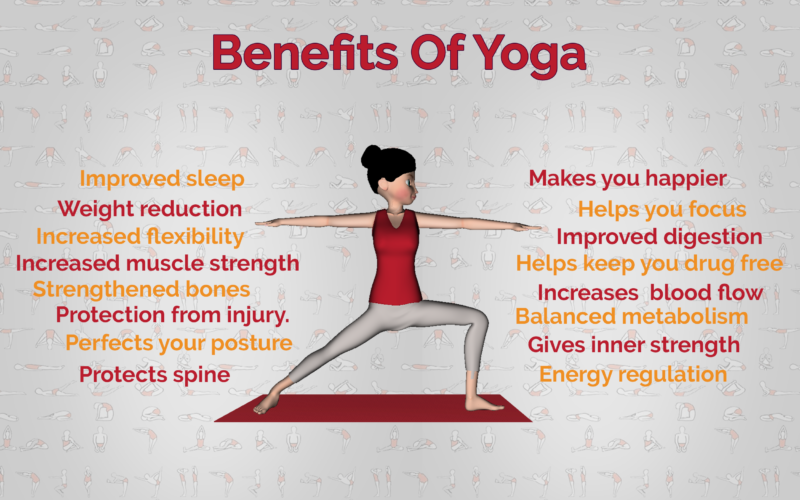<p>As per my father, the synonym of yoga is a healthy body and I believe him, despite physical and mental health benefits for people of all ages. <a href="http://wildhawk.in/definition-types-purpose-and-benefits-of-yoga/">Yoga</a> can help you, recovering from surgery, or a chronic condition, It can become an integral part of your treatment and potentially hasten to heal.</p>



<p>Adding yoga to your daily routine enhances, integration and unity of your mind, body, and spirit. Not only it will help you to get your body in shape, But It will also help you release stress and improve blood circulation in your body to make it healthier. In addition, yoga helps strengthen muscle capacity and concentration, Improves body flexibility, strengthens memory, improves poor posture, and improves blood pressure. Yoga also helps to get rid of, arthritis, depression, osteoporosis, backaches, headaches, and other diseases. Therefore, practicing yoga on a daily routine can bring many benefits to your life. Here are the seven major benefits of yoga:</p>



<h3 class="wp-block-heading">1) Improves Balance, Strength, and Flexibility.</h3>



<p>Slow movements and deep breathing increase blood flow and warm up muscles while holding a pose can build strength.</p>



<p><strong>Vrikshasana (Tree Pose)</strong>, Also known as standing &; balancing pose. Includes focus on muscles feet, ankles, thighs, chest, and shoulders.</p>



<p><strong>How to Do Vrikshasana or Tree Pose</strong></p>



<figure class="wp-block-image size-large"><img src="http://wildhawk.in/wp-content/uploads/2021/06/tree-pose-instructions-1024x704.jpg" alt="How to Do Vrikshasana or Tree Pose" class="wp-image-4174"/><figcaption>Vrikshasana or Tree Pose, PIC: Social Media</figcaption></figure>



<blockquote class="wp-block-quote is-layout-flow wp-block-quote-is-layout-flow"><p>“Stand straight on one leg, bending the right leg and placing the right feet on the left thigh: standing thus like a tree on the ground, is called Tree Posture”</p><cite>Gheranda Samhita 2.36</cite></blockquote>



<p><strong>Avoid If</strong>,</p>



<ul class="wp-block-list"><li>Suffering from headache, insomnia, or migraine.</li><li>Experienced recent injury in shoulders, legs, spine or arms.</li></ul>



<h3 class="wp-block-heading">2) Relieves Backpain.</h3>



<p>Yoga is as good as basic stretching for easing pain and improving mobility in people with lower back pain. The American College of Physicians recommends yoga as a first-line treatment for chronic low back pain.</p>



<p><strong>Bitilasana and Marjariasana (Cow-Cat Pose)</strong>, Bitilasana or Cow Pose is a spine warming up posture always practiced with its counterpoise Marjariasana or Cat Pose, also called forward bend or kneeling pose. Focuses mainly on Feet, ankles, thighs, chest, and shoulder.</p>



<p><strong>How to do Bitilasana or Cow Pose,</strong></p>



<figure class="wp-block-image size-large"><img src="http://wildhawk.in/wp-content/uploads/2021/06/bitilasana.jpg" alt="How to do Bitilasana or Cow Pose" class="wp-image-4176"/><figcaption>Bitilasana or Cow Pose, PIC: Social Media</figcaption></figure>



<p><strong>Avoid If</strong>,</p>



<ul class="wp-block-list"><li>You have a neck or knee injury.</li><li>carpal tunnel syndrome or ganglion cyst.</li></ul>



<p><strong>How to do Marjaryasana or Cat Pose,</strong></p>



<figure class="wp-block-image size-large"><img src="http://wildhawk.in/wp-content/uploads/2021/06/cat-pose-1024x683.jpg" alt="How to do Marjaryasana or Cat Pose" class="wp-image-4178"/><figcaption>Marjaryasana or Cat Pose, PIC: Social Media</figcaption></figure>



<p><strong>Avoid If</strong>,</p>



<ul class="wp-block-list"><li>Having an empty stomach.</li><li>Recent or deep injury in your spine, knees wrist or neck.</li><li>Having Arthritis of knee or wrist.</li></ul>



<h3 class="wp-block-heading">3) Ease Arthritis Symptoms.</h3>



<p>Gentle yoga has been shown to ease some of the discomforts of tender, swollen joints for people with arthritis.</p>



<h3 class="wp-block-heading">4) Improves Heart Health.</h3>



<p>Regular yoga practice may reduce levels of stress and body-wide inflammation, contributing to healthier hearts. Several of the factors contributing to heart disease, including high blood pressure and excess weight, can also be addressed through yoga.</p>



<p><strong>Adho Mukha Svanasana (Downward Dog Pose)</strong>, Also known as a forward bend or inversion pose. This pose is beneficial for digestion, stretching, and grounding.</p>



<p><strong>How to do Adho Mukha Svanasana or Downward Dog Pose</strong>,</p>



<figure class="wp-block-image size-large"><img src="http://wildhawk.in/wp-content/uploads/2021/06/down-dog-pose.png" alt="How to do Adho Mukha Svanasana or Downward Dog Pose" class="wp-image-4179"/><figcaption>Adho Mukha Svanasana or Downward Dog Pose, PIC: Social Media</figcaption></figure>



<p><strong>Avoid If</strong>,</p>



<ul class="wp-block-list"><li>Recent or a deep injury in your wrist, back, shoulders or legs.</li><li>Suffering from Carpal Tunnel Syndrome.</li><li>Having any kind of illness including fever and headache.</li></ul>



<h3 class="wp-block-heading">5) Relaxes and Help Sleep Better.</h3>



<p>Research shows that a consistent bedtime yoga routine can help you get in the right mindset and prepare your body to fall asleep and stay asleep.</p>



<p><strong>Viparita Karani (Legs Up the Wall Pose)</strong>, or Action of reversing where action of energy is reversed.</p>



<p>Don&#8217;t get confused between Viparita Karani and Sarvangasana,</p>



<figure class="wp-block-image size-large"><img src="http://wildhawk.in/wp-content/uploads/2021/06/difference-between-viparita-karani-and-sarvangasana.jpg" alt="Difference Between Viparita Karani and Sarvangasana" class="wp-image-4181"/><figcaption>Difference Between Viparita Karani and Sarvangasana, PIC: Social Media</figcaption></figure>



<p><strong>How to do Viparita Karani or Legs Up the Wall Pose</strong>,</p>



<figure class="wp-block-image size-large"><img src="http://wildhawk.in/wp-content/uploads/2021/06/Viparita-Karani-reversing-process.jpg" alt="How to do Viparita Karani or Legs Up the Wall Pose" class="wp-image-4180"/><figcaption>Viparita Karani or Legs Up the Wall Pose, PIC: Social Media</figcaption></figure>



<p><strong>Avoid If</strong>,</p>



<ul class="wp-block-list"><li>Having high blood pressure, heart disease problems, and thyroid disorders.</li><li>Just had your meals, This pose is suggested with empty stomach.</li></ul>



<h3 class="wp-block-heading">6) Enchases Energy.</h3>



<p>You may feel increased mental and physical energy, a boost in alertness and enthusiasm, and fewer negative feelings after getting into a routine of practicing yoga.</p>



<h3 class="wp-block-heading">7) Relieves Stress.</h3>



<p>According to the National Institutes of Health, scientific evidence shows that yoga supports stress management, mental health, mindfulness, healthy eating, weight loss, and quality sleep.</p>



<p><strong>Savasana (Corpse Pose)</strong>, Also known as mritasana is performed at the end of every yoga session is not easy as it looks as it requires concentration of mind to zero.</p>



<figure class="wp-block-image size-large"><img src="http://wildhawk.in/wp-content/uploads/2021/06/CorpsePoseSavasana-1024x616.jpg" alt="Savasana or Corpse Pose" class="wp-image-4182"/><figcaption>Savasana or Corpse Pose, PIC: Social Media</figcaption></figure>



<p><strong>Avoid If</strong>,</p>



<ul class="wp-block-list"><li>In the later stages of pregnancy.</li><li>Back injury and not able to perform the pose.</li></ul>



<h2 class="wp-block-heading">Scientific Research on Benefits of Yoga</h2>



<p>Numerous studies prove that yoga is beneficial in getting relief from arthritis, osteopenia, balance issues, oncology, women’s health, chronic pain, and many others.</p>

